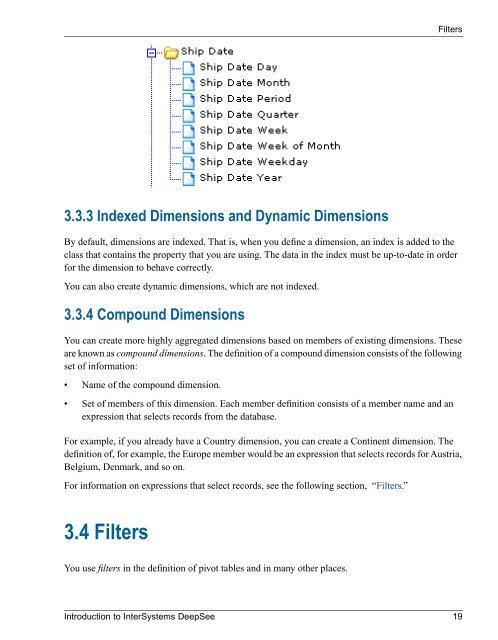Introduction to InterSystems DeepSee - InterSystems Documentation
Introduction to InterSystems DeepSee - InterSystems Documentation
Introduction to InterSystems DeepSee - InterSystems Documentation
Create successful ePaper yourself
Turn your PDF publications into a flip-book with our unique Google optimized e-Paper software.
Filters<br />
3.3.3 Indexed Dimensions and Dynamic Dimensions<br />
By default, dimensions are indexed. That is, when you define a dimension, an index is added <strong>to</strong> the<br />
class that contains the property that you are using. The data in the index must be up-<strong>to</strong>-date in order<br />
for the dimension <strong>to</strong> behave correctly.<br />
You can also create dynamic dimensions, which are not indexed.<br />
3.3.4 Compound Dimensions<br />
You can create more highly aggregated dimensions based on members of existing dimensions. These<br />
are known as compound dimensions. The definition of a compound dimension consists of the following<br />
set of information:<br />
• Name of the compound dimension.<br />
• Set of members of this dimension. Each member definition consists of a member name and an<br />
expression that selects records from the database.<br />
For example, if you already have a Country dimension, you can create a Continent dimension. The<br />
definition of, for example, the Europe member would be an expression that selects records for Austria,<br />
Belgium, Denmark, and so on.<br />
For information on expressions that select records, see the following section, “Filters.”<br />
3.4 Filters<br />
You use filters in the definition of pivot tables and in many other places.<br />
<strong>Introduction</strong> <strong>to</strong> <strong>InterSystems</strong> <strong>DeepSee</strong> 19

















